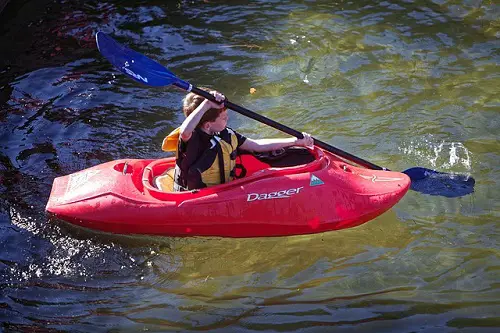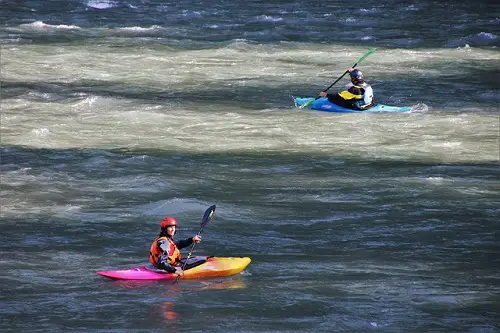Whitewater kayaks come in a variety of designs and sizes. So buying your first or next boat can be difficult with all the options on the market. When choosing a kayak, many people will want something with a lot of room. But what if it’s too big?
A whitewater kayak can be too big for someone to navigate efficiently and comfortably in rapids. The volume, width, or length of a boat will affect its performance on the water. If you choose a kayak that’s too big for you, it might be hard to maneuver and slow. So it’s important to select the right boat size for you.

But when you’re just getting started, it can be difficult to know how big of a kayak you should get. With all the specs and types of whitewater boats, even I can get confused, and I have been paddling on rivers since I was around 5. So I can’t imagine how overwhelming it must be for beginners.
The kayak size you should choose depends on many variables. Your weight, height, experience, and preferences will all come into play. For example, I’m relatively small and prefer tighter boats because it gives me more control in the water. But if you’re new to the sport, you might want a bigger kayak for more stability and room for your legs.
How To Choose The Right Size For A Whitewater Kayak?
The best way to choose the right kayak size is to try it out to see how it fits. You can also look at the manufacturer’s sizing guide to get an idea of what size you need. But there’s nothing better than going in the boat and taking it in whitewater to understand how it performs and if it’s too small or too big.
What Size Of Kayak Should You Get For Your Height & Weight?
Weight is generally the best measurement for choosing a kayak size because it’s what it needs to hold. Your height is also important, but you need to make sure you can float first. The volume of the boat will influence how much weight it can bear. So let’s take the popular Dagger Rewind as an example.
The Rewind XS, which is designed for kids, is made for paddlers between 65 – 120 lbs or 29 – 54 kg. Then, the SM model has a paddler weight range from 100 – 160 lbs or 45 – 73 kg. The Rewind MD is for kayakers between 140 – 220 lbs or 63.5 – 99.8 kg. Finally, the biggest version (LG) for larger paddlers can hold from 180 – 260 lbs or 81.6 – 118 kg.
| Rewind Kayak Size | Paddler Weight |
| XS | 65 – 120 lbs / 29 – 54 kg |
| SM | 100 – 160 lbs / 45 – 73 kg |
| MD | 140 – 220 lbs / 63.5 – 99.8 kg |
| LG | 180 – 260 lbs / 81.6 – 118 kg |
The paddler weight in this table was retrieved from Dagger.
There’s usually no sizing guide according to the height. But the taller you are, the more volume and length you generally want. You need a kayak with enough legroom and more volume for extra stability because your center of gravity is higher.
Now, here are some tables with general guidelines to help you choose the right kayak size according to your weight and height.
| Kayak Volume | Paddler Weight | Paddler Height |
| Low Volume (SM) | < 140 lbs / < 63.5 kg | < 5’6 ft / < 170 cm |
| Medium Volume (MD) | 150 – 180 lbs / 68 – 81.6 kg | 5’6 – 5’10 ft / 170 – 178 cm |
| High Volume (LG) | 180 lbs + / 81.6 kg + | 5’10 ft + / 178 cm + |
Some data and information from this table were retrieved from Boat Safe.
| Paddler Height | Whitewater Kayak Length |
| < 5’ | 4 to 8 ft |
| 5’ – 5’6 | 4 to 8 ft |
| 5’6 -6’ | 5 to 9 ft |
| 6’ + | 6 to 9 ft |
The data and information in this table were retrieved from Kayak Addicts.
As you can see with the Rewind kayak example, there are overlaps between sizes. I weigh around 155 lbs, so I fit in the SM and MD range. And I’m probably not the only one in that situation. So which one should I choose?
Should You Size Up Or Down For A Whitewater Kayak?
When you fall in between kayak sizes, it’s generally better to size up because a kayak that’s too small might be tight, unstable, and sit low in the water. So a bigger boat will probably be more comfortable and performant. It will also give you enough room for your legs and more capacity for extra gear.
But a tight fit might be good for optimal control over your boat, especially for freestyle kayaking. That’s why playboats are so small. Besides that, it shouldn’t be too big either. The best way to find the right size between the two models is to try both and see what fits best.
With that said, I should probably go with the Rewind MD because I’m too close to the kayak weight limit of the SM. With my paddling equipment, I will probably go over the capacity, which might negatively affect my experience on the water. So I should size up.
How Big Is Too Big For A Whitewater Kayak?
If you’re under the recommended paddler’s weight, the whitewater kayak is probably too big for you. Being too loose or having too much space for your legs are other signs you should get a smaller boat. Ultimately, the best way to know if a kayak is too big is to get in it and test it on the water.
For example, the Rewind LG would probably be too big for me. Even with my paddling clothes and extra gear, I would hardly reach the minimum weight. So the range can give you a good idea of what size you should get. But I would need to try it out to make sure it’s accurate.
What Happens If A Whitewater Kayak Is Too Big?
If your whitewater kayak is too big, it might not be comfortable and easy to navigate. Too much volume, length, or width can make a boat slow to react, not track well, and hard to roll. So a big kayak will be hard to control and not perform at its best, especially in rapids. It’s kind of like wearing oversize shoes.
Last Thoughts About Big Whitewater Kayaks!
Finally, whitewater kayaks can be too big, and it might affect their performance on the water. So you should make sure to choose the right size for you. The recommended paddler’s weight is a good place to start, but trying the boat is the best way to know if it fits.

When you fall in between sizes, you should generally take the bigger one. But don’t size up too much. Otherwise, it might be too loose and difficult to maneuver. That’s why it’s important not to get and use a kayak that’s too big.
Let’s Find The Right Kayak Size!
